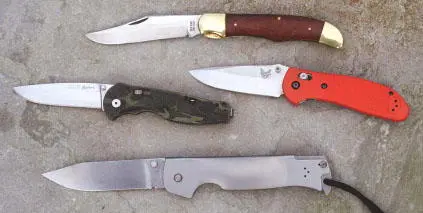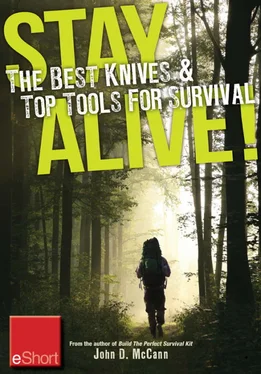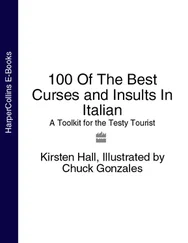John D. McCann
STAY ALIVE
KNIVES AND TOOLS FOR SURVIVAL
Many survival experts agree that, outside of the brain, the most important survival tool is a knife. I have always agreed with an old Nordic Proverb, “A knifeless man is a lifeless man.” Nothing is more true in a survival situation. If I could choose only one item for a survival kit or survival, it would be a knife. With a knife, I can make almost anything else I need in a survival situation. However, a discussion on knives is like a discussion on guns. It can be controversial and nobody will agree on all points. Because of its importance we will examine the issue.
I’m often asked what is the best survival knife. I always say that the best survival knife is the one that works for you and performs the tasks you need to accomplish. However, there is more to it than that. There are some specific characteristics that make certain knives better for the purpose of survival. Figure 4-1 describes characteristics desired in a survival knife.
Understanding the various knife grinds and points also helps you make a better decision in regard to an adequate survival knife. Figure 4-2 provides information that will help you better understand the types of grinds and points. Although I prefer a convex or Scandi grind with a drop point made from carbon steel for a survival knife, any of those described are suitable for survival.
Last, but not least, you should be somewhat knowledgeable about heat treating a knife. Knives come in a plethora of different steels, most of which are good as long as they are heat treated properly. A knife without a proper heat treat and proper tempering can end up being as useful as a butter knife. A bad heat treat can lead to a multitude of problems. If the knife is too soft it will not retain a cutting edge for very long and the edge can be prone to rolling. If a knife is too hard it can be brittle and end up chipping.
Heat treating and tempering procedures vary from steel to steel and are also dependent on the type and style of knife. Most knife manufacturing companies spend lots of time testing and perfecting the heat treating processes because it is one of the most important factors in the end product. The ideal Rockwell hardness for your average carbon steel or tool steel field knife is around 58 or 59, a couple of points up or down and you would be hard pressed as an average user to notice a difference.
The hardness of a knife also varies based on the size and intended use of the knife. A big chopper-style knife can get away with being a bit on the soft side, as it is intended to be used more like an axe or hatchet than a small carving knife. And, a small carving knife can be a little on the hard side for better edge retention and less impact resistance. A machete, for example is really on the soft side of the Rockwell scale because its intended use is for brush clearing/chopping and it needs to be flexible. A machete is usually very long and thin, and if were heat treated to be hard like a field knife, it wouldn’t last long and most likely the blade would snap.
My suggestion is always spend good money on a knife. As we have established, it is your primary survival tool, so don’t cut corners here. Buy well-known brands and don’t look for bells and whistles. The knife needs to cut, and cut adequately for your needs.
Two types of knives to avoid at all costs are hollow handle knives and double-edged blades. Hollow handle knives are intrinsically weak where the handle is attached to the blade. Not only are most of these very cheap knives, they will always break between the handle and blade leaving you with no knife. The exception to this rule are knives made by Chris Reeve, which are hollow-handle survival knives made from a single bar of A2 steel. If you must have a hollow handle knife, this is the one.
With regard to double edged blades, they are made for self defense, period. They are not, in my opinion, useful for survival purposes, at least in the wilderness.
Non-primary survival kit knives
Now that we’ve established the ideal type of knife for survival, we must consider what type of knife will fit in our survival kit. There are always trade-offs, and my suggestion is to always carry a good fixed blade knife that meets or exceeds the characteristics described above. However, as my dad always said, you can’t have too many knives. Therefore, let’s examine some other types of knives that, if placed in a survival kit, could be a back-up to your main blade.
Razor blades
Although not really considered a knife, razor blades are a cutting instrument that will normally fit in the smallest survival kit. Not intended as a major cutting tool, but something to use if all else fails, various types of blades fit this category.

Examples of razor-type blades include a surgical prep blade, utility knife blade, X-ACTO knife blade, a Warren Cutlery carving blade and a folding razor knife.
Survival tin knives
Survival tin knives are any knife that fits into a small survival tin and are meant as a back-up to your primary knife.

A custom kit knife made for the author, a CRKT Ritter RSK Mk5, a Gerber LST, a Gerber folding Utility knife, and a Victorinox Silver Alox Farmer. All of these knives fit easily in a small survival tin.
Multiple blade folders

Various multiple blade folders that would work fine as a back-up knife for a survival kit: (in a clockwise direction, beginning at top left) an original Boy Scout knife, a military folding knife. a Victorinox Alox Farmer (without the saw blade showing), a Victorinox Hunter, and a Victorinox plain edge One Hand Trekker.
There are many types of multiple blade folding knives on the market and they run from usable to ridiculous. If you choose a multiple blade knife, keep it simple. Some of these knives have so many blades that the handle makes them impossible to hold.
Some of my favorites are the original Boy Scout knife and military folding knife. Both have a good drop point blade, an awl, and a bottle and can opener. You will never regret having one of these in a survival kit. The next type are a little larger, but have the advantage of a saw and the best, in my opinion, are the Victorinox and Wenger. My favorite is the Victorinox Farmer, which I carry every day, and the plain edged One Hand Trekker, one of which rides in a shoulder strap pouch on each of my packs. Both of these knives have an excellent saw which is great for cutting the “V” notch in a fire board for a bow and drill or to start a notch on a trap.
Single blade folders

The author has had this Ka-Bar folder (top) forever and it is still a good knife. In the second row is a SOG 4-1/2” drop point Flash II (left), and a Benchmade Griptilian drop point (right). The bottom row shows one of the larger folders made by Cold Steel called the Pocket Bushman.
There has been much discussion about a single blade folder being a primary survival knife, and the discussion will continue I’m sure. As I have established, my primary survival knife will always be a fixed-blade (full tang) knife. I once heard somebody say that a folding knife is one that is already broken in the middle. That is true of course, and that will always be the weak point of a folder. Don’t get me wrong, I carry a Benchmade Griptilian, drop point, every day. I just don’t consider it my primary knife, but a back-up blade.
Читать дальше















